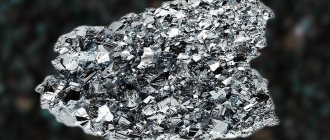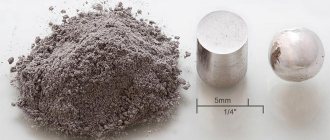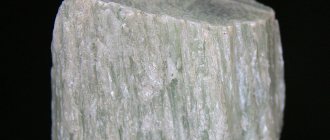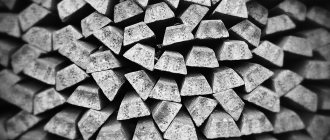Platinum group metals, or platinoids, are 6 precious chemical elements of a noble appearance. They are located in the periodic table in one row and are transition metals of 8-10 groups of 5-6 periods. Externally, the metals are similar to each other.
Platinum group metals include:
- Platinum.
- Palladium.
- Rhodium.
- Ruthenium.
- Iridium.
- Osmium.
The main features of the platinum group metals are:
- silver-gray tint, except osmium (white-blue);
- crystalline properties that help accelerate chemical processes;
- catalysts that control the rate of oxidation and hydrogenation reactions;
- chemically resistant metals to the action of many reagents;
- have high electrical conductivity;
- withstand high temperatures;
- infusibility.
The main sources of platinum metals are rare element minerals. Today, precious platinum metals are used in jewelry production, but to varying degrees, and biologically active compounds of platinum metals are used in medicine.
Platinum group metals: list
The group consists of the following six chemical elements, arranged in order of increasing atomic weight:
- Ru – ruthenium.
- Rh – rhodium.
- Pd – palladium.
- Os – osmium.
- Ir – iridium.
- Pt – platinum.
The platinum group metals are silvery-white in color, with the exception of osmium, which is bluish-white. Their chemical behavior is paradoxical in that they are highly resistant to most reagents, but are used as catalysts that easily accelerate or control the rate of oxidation, reduction, and hydrogenation reactions.
Ruthenium and osmium crystallize into a hexagonal close-packed system, while others have a face-centered cubic structure. This is reflected in the greater hardness of ruthenium and osmium.
History of discovery
Although platinum-bearing gold artifacts date back to 700 BC. e., the presence of this metal is more likely an accident than a pattern. Jesuits in the 16th century mentioned gray dense pebbles associated with alluvial gold deposits. These stones could not be melted, but they formed an alloy with gold, and the ingots became brittle and could no longer be cleaned. The pebbles came to be called platina del Pinto - granules of silvery material from the Pinto River, which flows into the San Juan River in Colombia.
Malleable platinum, which can only be obtained after complete purification of the metal, was isolated by the French physicist Chabanot in 1789. It was used to make a cup presented to Pope Pius VI. The discovery of palladium in 1802 was reported by the English chemist William Wollaston, who named the chemical. element of the platinum group of metals in honor of the asteroid. Wollaston subsequently claimed to have discovered another substance present in platinum ore. He named it rhodium because of the pink color of the metal salts. The discoveries of iridium (named after the rainbow goddess Iris because of the variegated color of its salts) and osmium (from the Greek word for "smell" because of the chlorine odor of its volatile oxide) were made by the English chemist Smithson Tennant in 1803. French scientists Hippolyte-Victor Collet-Descoti, Antoine-François Fourcroy, and Nicolas-Louis Vauquelin isolated the two metals simultaneously. Ruthenium, the last element isolated and identified, received its name from the Latin name for Russia from the Russian chemist Karl Karlovich Klaus in 1844.
In contrast to substances such as gold, silver, which are easily isolated in a relatively pure state by simple fire refining, platinum group metals require complex water-chemical processing. These methods were not available until the late 19th century, so identification and isolation of the platinum group lagged behind silver and gold by thousands of years. Additionally, the high melting point of these metals limited their use until researchers in Britain, France, Germany, and Russia developed methods to convert platinum into a workable form. How platinum group precious metals have been used in jewelry since 1900. Although such applications remain relevant today, industrial applications have far surpassed them. Palladium became a highly sought after contact material in telephone relays and other wired communication systems, providing long life and high reliability, and platinum, because of its resistance to spark erosion, was used in combat aircraft spark plugs during World War II.
After the war, the expansion of molecular conversion techniques in petroleum refining created a huge demand for the catalytic properties possessed by platinum group metals. By the 1970s, consumption increased even further when automobile emissions standards in the United States and other countries led to the use of these chemicals in catalytic conversion of exhaust gases.
General characteristics of platinum metals
The general name of platinum metals combines the elements of the second and third triads of the eighth group of the periodic table: ruthenium, rhodium, palladium, osmium, iridium and platinum. These elements form a group of rather rare metals, similar in their properties to each other, so separating them presents significant difficulties.
In nature, platinum metals occur almost exclusively in the native state, usually all together, but never in iron ores.
Platinum metals are low-active and very resistant to chemical influences. Some of them are insoluble not only in acids, but also in aqua regia.
Osmium crystals
Ruthenium, rhodium, osmium and iridium are refractory. Despite their low availability and high cost, these metals, along with platinum, have versatile technical applications that are increasing year by year.
Although platinum metals can exhibit different oxidation states in compounds, they are especially typical of compounds in which their oxidation state is +4. Osmium and ruthenium are also characterized by compounds with the oxidation state of these elements +8.
Osmium (VIII) oxide, or osmium tetroxide, OsO 4 is the most stable of the oxides of this element. It is slowly formed even when osmium is stored in air and is a low-melting (melting temperature 41 o C) crystals of pale yellow color. OsO4 vapors have a pungent odor and are very poisonous.
Osmium tetroxide dissolves quite well in water, and its solution does not give an acidic reaction to litmus. However, as was first established by L.A. Chugaev (1918), OsO4 forms fragile complex compounds with strong alkalis.
Possessing pronounced oxidizing properties, OsO4 reacts vigorously with organic substances, being reduced to black osmium dioxide OsO2. This is the basis for the use of OsO4 for staining microscopic preparations.
Ruthenium crystal
VIII oxide or ruthenium tetroxide, RuO4 , are solid crystals of golden yellow color, melting at 25.4 o C and soluble in water. Ruthenium tetroxide is much less stable than OsO4, and at a temperature of about 108 o C (below the boiling point) it decomposes explosively into RuO2 and oxygen.
Osmium fluoride (VIII), or osmium octafluoride, OsF8 is obtained by direct combination of osmium with fluorine at 250 o C in the form of colorless vapors, which condense upon cooling into lemon-yellow crystals with a melting point of 34.4 o C.
Osmium octafluoride exhibits pronounced oxidizing properties. With water it gradually decomposes into osmium tetroxide and hydrogen fluoride:
OsF8 + 4H2O = OsO4 + 8HF
All platinum metals exhibit a pronounced tendency to form complexes.
Platinum. Platinum has been known in South America since pre-Columbian times. This metal is similar in color and shine to silver, which is why the Spaniards, who conquered most of the continent, called it platinum (Spanish platina - a diminutive of plata - “silver”). The properties of platinum were described by the Spanish officer Don Antonio de Ulloa in 1748.
Platinum crystal
In nature, platinum, like gold, is found in placers in the form of grains, always containing impurities of other platinum metals.
Platinum is a white, shiny, malleable metal that does not change in air even when heated. Some acids have no effect on it. Platinum dissolves in aqua regia, but is much more difficult to dissolve than gold.
In the chemical industry, platinum is used to make corrosion-resistant equipment parts. Platinum anodes are used in a number of electrochemical industries (production of persulfuric acid, perchlorates, perborates). Platinum is widely used as a catalyst, especially when carrying out redox reactions. It represents the first heterogeneous catalyst known since the beginning of the 19th century. Currently, platinum catalysts are used in the production of sulfuric and nitric acids, in the purification of hydrogen from oxygen impurities and in a number of other processes. Platinum is used to make heating elements for electric furnaces and temperature measuring instruments (resistance thermometers and thermocouples). In a highly dispersed state, platinum dissolves significant amounts of hydrogen and oxygen. The use of platinum for the manufacture of a hydrogen electrode is based on its ability to dissolve hydrogen.
In most of its compounds, platinum exhibits oxidation states of +2 and +4. In both states, it has a pronounced ability to form complex compounds; Platinum(IV) compounds are more important.
When platinum is dissolved in aqua regia, hexachloroplatinum, or hydroplatinic acid, H2[PtCl6] is obtained, which, when the solution is evaporated, is released in the form of red-brown crystals of the composition H2[PtCl6] •6H2O. The potassium salt of this acid is one of the least soluble potassium salts. Therefore, its formation is used in chemical analysis to discover potassium.
When heated in a stream of chlorine to 360 °C, hexachloroplatinic acid decomposes with the release of hydrogen chloride and the formation of platinum (IV) chloride PtCl4.
If alkali is added to a solution of H2[PtCl6], a brown precipitate forms. This substance is called platinic acid, since when dissolved in excess alkali it forms a salt. Platinum (IV) oxide PtO2 is also known.
II ) chloride is produced by passing chlorine over finely crushed platinum. It has a greenish color and is insoluble in water.
Complex compounds of platinum (II) include, for example, salts of tetracyanoplatinic (P) acid H2[Pt(CN)4]. The barium salt of this acid, Ba[Pt(CN)4], exhibits bright fluorescence when exposed to ultraviolet and x-rays and is used in fluoroscopy to cover fluorescent screens.
Palladium (Pall adium ). Iridium (lridium). Palladium is a silvery-white metal, the lightest of the platinum metals, the softest and most malleable. It is remarkable for its ability to absorb huge amounts of hydrogen (up to 900 volumes per 1 volume of metal). In this case, palladium retains its metallic appearance, but significantly increases in volume, becomes brittle and easily forms cracks. The hydrogen absorbed by palladium is apparently in a state approaching the atomic state and is therefore very active. A palladium plate saturated with hydrogen converts chlorine, bromine and iodine into hydrogen halides, reduces iron (III) salts into iron (II) salts, mercury (II) salts into mercury (I) salts, and sulfur dioxide into hydrogen sulfide.
Palladium coin
Some types of laboratory glassware, as well as parts of equipment for separating hydrogen isotopes, are made from palladium. Palladium-silver alloys are used in communication equipment, in particular, for the manufacture of contacts. Temperature regulators and thermocouples use alloys of palladium with gold, platinum and rhodium. Some palladium alloys are used in jewelry and dental practice.
When deposited on asbestos, porcelain, or other supports, palladium serves as a catalyst for a series of redox reactions. This property is used both in the laboratory and in industry in the synthesis of certain organic compounds. Palladium catalyst is used to purify hydrogen from traces of oxygen, as well as oxygen from traces of hydrogen.
Chemically, palladium differs from other platinum metals by being significantly more active. When heated red-hot, it combines with oxygen to form PdO oxide and dissolves in nitric acid, hot concentrated sulfuric acid and aqua regia.
Like platinum, palladium has oxidation states of +2 and +4; palladium(II) compounds are more stable. Most palladium salts are soluble in water and are highly hydrolyzed in solutions. Palladium (II) chloride PdCl2 is very easily reduced in solution to metal by some gaseous reducing agents, in particular carbon monoxide (II), which is the basis for its use for the discovery of carbon monoxide in gas mixtures. It is also used as a catalyst for some redox reactions.
Iridium
Iridium differs from platinum in having a very high melting point and even greater resistance to various chemical influences. Neither individual acids nor aqua regia affect iridium. In addition, iridium is significantly superior to platinum in its hardness.
Pure iridium is used to make some scientific instruments. For the same purpose, an alloy containing 90% platinum and 10% iridium is used. The international standards of the meter and kilogram are made from this alloy.
Download:
Download free essay on the topic: “Platinum metals” Platinum-metals.docx (242 Downloads)
You can download abstracts on other topics here
Similar
Ore
With the exception of small placer deposits of platinum, palladium and osmic iridium (an alloy of iridium and osmium), there is practically no ore in which the main component is the chemical element - a platinum group metal. The minerals are typically found in sulfide ores, particularly pentlandite (Ni, Fe)9S8. The most common are laurite RuS2, irarsite, (Ir,Ru,Rh,Pt)AsS, osmiridium (Ir,Os), cooperite, (PtS) and braggite (Pt,Pd)S.
The world's largest deposit of platinum group metals is the Bushveld complex in South Africa. Large reserves of raw materials are concentrated in the Sudbury deposits in Canada and the Norilsk-Talnakh deposits in Siberia. In the United States, the largest deposits of platinum group minerals are located in Stillwater, Montana, but there they are much smaller than in South Africa and Russia. The world's largest platinum producers are South Africa, Russia, Zimbabwe and Canada.
History[edit]
Naturally occurring platinum and platinum-rich alloys were known to pre-Columbian Americans for many years. [4] However, despite the metal's use by pre-Columbian peoples, the first mention of platinum in Europe appears in 1557 in the writings of Italian humanist Julius Caesar Scaliger (1484–1558) as a description of a mysterious metal found in the Central American mines between Darien ( Panama) and Mexico (“it is still impossible to melt any of the Spanish arts”). [4]
The name platinum comes from the Spanish word platina
"little silver" is the name given to the metal by Spanish settlers in Colombia. They considered platinum an undesirable impurity in the silver they mined. [4] [5]
By 1815, rhodium and palladium were discovered by William Hyde Wollaston, and iridium and osmium were discovered by his close friend and collaborator Smithson Tennant. [6]
Mining and enrichment
The main South African and Canadian deposits are exploited by mining. Virtually all platinum group metals are recovered from copper or nickel sulfide minerals using flotation separation. Smelting the concentrate produces a mixture that is washed out of copper and nickel sulfides in an autoclave. The solid leach residue contains 15 to 20% platinum group metals.
Gravity separation is sometimes used prior to flotation. The result is a concentrate containing up to 50% platinum metals, eliminating the need for smelting.
Incident[edit]
As a rule, ultramafic and mafic igneous rocks have relatively high, and granites low, trace amounts of PGE. Geochemical anomalous traces occur predominantly in chromian spinels and sulfides. Mafic and ultramafic igneous rocks contain virtually all of the world's primary PGMs. The major layered intrusions, including the Bushveld complex, far exceed all other geological settings for platinum deposits. [10] [11] [12] [13] Other economically significant deposits of platinum group metals include basic intrusions associated with flood basalts, and ultramafic complexes such as Alaska and the Urals. [11]: 230
Mechanical properties
Platinum group metals differ significantly in their mechanical properties. Platinum and palladium are quite soft and very malleable. These metals and their alloys can be worked in both hot and cold conditions. Rhodium is first worked hot and can later be worked cold with fairly frequent annealing. Iridium and ruthenium must be heated; they cannot be cold processed.
Osmium is the hardest of the group and has the highest melting point, but its tendency to oxidize has its limitations. Iridium is the most corrosion-resistant of the platinum metals, and rhodium is valued for maintaining its properties at high temperatures.
Platinum
Platinum has been known since ancient times, and the name comes from the Spanish language: “little silver.” The conquistadors were the first Europeans to become acquainted with platinum in the mid-16th century in South America. And in 1735, the king of Spain issued a decree according to which platinum should be drowned in the river and not brought into the country. Later the river was named Platino del Pinto. The decree was repealed only forty years later, for the falsification of gold and silver coins by the Madrid authorities. Later, alchemists became acquainted with platinum, but considered it unsuitable. But in France it still found its use in the form of a standard meter and then a kilogram. In Russia, the metal was called white gold, having been found in placer gold.
Platinum is one of the rarest metals, because its content in the earth's crust is low. The main deposits of platinum are: Russia, USA (2 large mines: Stillwater, East Bouder), China, Zimbabwe (9 tons), South Africa (Bushwell complex).
In Russia, this PGM metal has a unique base, with a huge number of deposits, the main of which is located in Zarechensk (Murmansk region).
Platinum mining is a labor-intensive process, of two types:
- Open mining method: in secondary placer deposits. There, platinum is concentrated as a result of the destruction of the primary rock.
- Closed mining method: in primary deposits, with the construction of mines, drilling holes in rocks, laying explosives and the explosion itself.
Platinum is a precious metal used in jewelry and industry. The properties of platinum are wide:
- heavier than gold and silver;
- does not oxidize;
- does not react with other elements when heated;
- ductile metal;
- has good electrical conductivity;
- does not dissolve under the influence of acids;
- high melting point;
- good malleability.
The scope of platinum is quite wide and is not limited to jewelry production, because it has unique beauty and nobility. Currently, the price of metal is growing, as it is also used in industry. So, the uses of platinum:
- jewelry production, for the manufacture of various types of jewelry;
- medicine;
- chemical industry;
- shipbuilding;
- aircraft manufacturing;
- space sphere;
- glass industry;
- banking.
Structural Applications
Because clean annealed platinum is so soft, it is susceptible to scratches and deterioration. To increase hardness, it is alloyed with many other elements. Platinum jewelry is very popular in Japan, where it is called "hakkin" and "white gold." Jewelry alloys contain 90% Pt and 10% Pd, which is easy to process and solder. The addition of ruthenium increases the hardness of the alloy while maintaining oxidation resistance. Alloys of platinum, palladium and copper are used in forged products because they are harder than platinum-palladium and less expensive.
Crucibles used to produce single crystals in the semiconductor industry require corrosion resistance and stability at high temperatures. Platinum, platinum-rhodium and iridium are best suited for this application. Platinum-rhodium alloys are used in the production of thermocouples, which are designed to measure elevated temperatures up to 1800 °C. Palladium is used both in pure and mixed form in electrical devices (50% of consumption) and in dental alloys (30%). Rhodium, ruthenium and osmium are rarely used in their pure form - they serve as an alloying additive for other platinum group metals.
Notes[edit]
- ^ a b
Renner, H.;
Schlamp, G.; Kleinwächter, I.; Drost, E.; Lüschow, H. M.; Tews, P.; Panster, P.; Diehl, M.; and others. (2002). "Metals and compounds of the platinum group." Ullman Encyclopedia of Industrial Chemistry
. Wiley. DOI: 10.1002/14356007.a21_075. ISBN 3527306730. - Harris, D.C.; Cabri LJ (1991). “Nomenclature of alloys with platinum group elements; review and revision". Canadian mineralogist
.
29
(2): 231–237. - Rollinson, Hugh (1993). Using Geochemical Data: Assessment, Presentation, Interpretation
. Longman Science and Technology. ISBN 0-582-06701-4. - ^ a b c
Weeks, M. E. (1968).
Discovery of the Elements
(7th ed.). Journal of Chemical Education. pp. 385–407. ISBN 0-8486-8579-2. OCLC 23991202. - Woods, Ian (2004). Elements: Platinum
. Test books. ISBN 978-0-7614-1550-3. - Platinum Metals Rev., 2003, 47, (4), 175. Bicentenary of the Four Platinum Group Metals PART I: RHODIUM AND PALLADIUM - EVENTS SURROUNDING THEIR DISCOVERIES (W.P. Griffith)
- Hunt, L.B.; Lever, F. M. (1969). "Platinum Metals: A Review of Manufacturing Resources for Industrial Use" (PDF). Review of Platinum Metals
.
13
(4):126–138. Retrieved October 2, 2009. - Ravindra, Khaiwal; Bench, Laszlo; Van Grieken, Rene (2004). "Platinum group elements in the environment and their health hazards." Environmental Science in General
.
318
(1–3):1–43. Bibcode: 2004ScTEn.318…. 1R. DOI: 10.1016/S0048-9697(03)00372-3. hdl: 2299/2030. PMID 14654273. - Aruguete, Deborah M.; Wallace, Adam; Blakeney, Terry; Kerr, Rose; Gerber, Galen; Ferko, Yakov (2020). "Palladium Release from Catalyst Materials Caused by Chloride and Ferrocyanide Components of Road Deicer." Chemosphere
.
245
: 125578. Bibcode: 2020Chmsp.245l5578A. DOI: 10.1016/j.chemosphere.2019.125578. PMID 31864058. - Jump up
↑ Buchanan, D. L. (2002).
Cabri, L. J. (ed.). "Geology of the Platinum Group Elements". CIM Special Volume 54: Geology, Geochemistry, Mineralogy and Mineral Enrichment of Platinum Group Elements
. Montreal: Canadian Institute of Mining, Metallurgy and Petroleum. - ^ a b c
Pohl, Walter L. (2011).
Economic Geology: Principles and Practice
. Oxford: Wiley-Blackwell. ISBN 978-1-4443-3662-7. - Zereini, Fathi; Wiseman, Claire L. S. (2015). Platinum metals in the environment
. Berlin: Springer Professional. - Mungall, J. E.; Naldrett, A. J. (2008). "Ore deposits of platinum group elements." Elements
.
4
(4): 253–258. DOI: 10.2113/GSELEMENTS.4.4.253. - Bernardis, Florida; Grant, R.A.; Sherrington, D. C. (2005). "Review of methods for separating platinum group metals through their chloro complexes." Reactive and functional polymers
.
65
(3):205–217. DOI: 10.1016/j.reactfunctpolym.2005.05.011. - "Mineral Profile: Platinum". British Geological Survey
. September 2009. Retrieved February 6, 2021. - "Search for minerals by chemical composition - platinum". www.mindat.org
. Retrieved February 8, 2021. - Fake, Katie. "Platinum | Museum of Earth Sciences | University of Waterloo". University of Waterloo
. Retrieved February 6, 2021. - Xiao, Z.; Laplante, A. R. (2004). "Characterization and recovery of platinum group minerals—a review." Mineral Engineering
.
17
(9–10): 961–979. DOI: 10.1016/j.mineng.2004.04.001. - ^ a b c d
"Platinum group metals" (PDF). USGS, Mineral Commodity Summaries. January 2007. Retrieved September 9, 2008. - Bardi, Hugo; Caporali, Stefano (2014). "Precious Metals in Automotive Technology: An Intractable Depletion Problem?" . Minerals
.
4
(2):388–398. DOI: 10.3390/min4020388. Retrieved December 22, 2020. - Emsley, J. (2003). "Iridium". Nature's Building Blocks: A-Z Guide to the Elements
. Oxford, England, UK: Oxford University Press. pp. 201–204. ISBN 0-19-850340-7. - ^ a b
Chevalier, Patrick. "Platinum Group Metals" (PDF). Natural Resources of Canada. Archived from the original (PDF) on August 11, 2011. Retrieved October 17, 2008. - Sebastian, Rauch (November 2012). "Anthropogenic enrichment of platinum in the vicinity of mines at the Bushveld Igneous Complex, South Africa". Retrieved February 14, 2021.
- Hunt, L.B.; Lever, F. M. (1969). "Platinum Metals: A Review of Manufacturing Resources for Industrial Use" (PDF). Review of Platinum Metals
.
13
(4):126–138. Retrieved October 2, 2009. - Bernardis, Florida; Grant, R.A.; Sherrington, DC "Review of methods for separating platinum group metals through their chloro complexes" Reactive and Functional Polymers 2005, Vol. 65, p. 205-217. DOI: 10.1016/j.reactfunctpolym.2005.05.011
- Jump up
↑ RJ Newman, FJ Smith (1970).
"Platinum Nuclear Decay Metals—An Assessment of Their Potential Industrial Use" (PDF). Review of Platinum Metals
.
14
(3): 88. - Zdenek Kolarik, Edouard V. Renard (2003). “Recovery of valuable fission platinoids from spent nuclear fuel; PART I: General Considerations and Fundamentals of Chemistry" (PDF). Review of Platinum Metals
.
47
(2): 74. - Kolarik, Zdenek; Renard, Edouard V. (2005). "Possible industrial applications of fission platinoids" (PDF). Review of Platinum Metals
.
49
(2): 79. DOI: 10.1595/147106705X35263. - Zdenek Kolarik, Edouard V. Renard (2003). “Recovery of valuable fission platinoids from spent nuclear fuel; PART II: The Separation Process" (PDF). Review of Platinum Metals
.
47
(3): 123. - Gao, Bo; Yu, Yanke; Zhou, Huaidong; Lu, Jin (2012). "Accumulation and distribution characteristics of platinum group elements in roadside dust in Beijing, China". Environmental toxicology and chemistry
.
31
(6):1231–1238. DOI: 10.1002/etc.1833. PMID 22505271. - ^ a b c d e
Hajval Ravindra, Laszlo Bench, Rene Van Grieken (5 January 2004).
"Platinum group elements in the environment and their health hazards." Environmental Science in General
.
318
(1–3):1–43. Bibcode: 2004ScTEn.318…. 1R. DOI: 10.1016/S0048-9697(03)00372-3. hdl: 2299/2030. PMID 14654273. CS1 maint: multiple names: authors list (link) - ^ a b c
Claire L. S. Wiseman, Fathi Zereini (2012).
"Airborne Particulate Matter, Platinum Group Elements, and Human Health: A Review of Recent Evidence." Environmental Science in General
.
407
(8):2493–2500. DOI: 10.1016/j.scitotenv.2008.12.057. PMID 19181366. - Makk, Maideyi; With love, David; Mapani, Benjamin (2006). "Zimbabwean rock dumps and their impact on river water quality - an exploratory study". Physics and Chemistry of the Earth, Parts A/B/C
.
31
(15–16): 797–803. Bibcode: 2006PCE…. 31..797M . DOI: 10.1016/j.pce.2006.08.029. - Hunt, L.B.; Lever, F. M. (1969). "Platinum Metals: A Review of Manufacturing Resources for Industrial Use" (PDF). Review of Platinum Metals
.
13
(4):126–138. Retrieved October 2, 2009.
Catalysts
About 42% of all platinum produced in the West is used as a catalyst. Of these, 90% are used in automotive exhaust systems, where refractory pellets or honeycomb structures coated with platinum (as well as palladium and rhodium) help convert unburned hydrocarbons, carbon monoxide and nitrogen oxides into water, carbon dioxide and nitrogen.
An alloy of platinum and 10% rhodium in the form of a red-hot metal mesh serves as a catalyst in the reaction between ammonia and air to produce nitrogen oxides and nitric acid. When fed with a mixture of ammonia, methane can produce hydrocyanic acid. In petroleum refining, platinum on the surface of alumina beads in a reactor acts as a catalyst to convert long-chain petroleum molecules into branched isoparaffins, which are desirable in high-octane gasoline blends.
Osmium
Pure osmium does not exist in nature; it is found in a complex with rhodium. Osmium deposits are concentrated in: Africa (south), Tasmania, Australia, USA, Canada, Russia, Colombia, South Africa (the largest reserves).
Characteristics of osmium:
- silver-blue crystals;
- pungent odor when interacting with substances;
- insoluble in alkalis and acids, mixtures of hydrochloric and nitric acids;
- chemical inertness;
- Powdered osmium is a raw material for products, slowly susceptible to dissolution;
- hard and brittle;
- refractory;
- high density: the heaviest metal.
Electroplating
All platinum group metals can be plated. Because of the hardness and shine of the resulting coating, rhodium is most often used. Although its cost is higher than platinum, its lower density allows it to use less material at a comparable thickness.
Palladium is a platinum group metal that is the easiest to use for coating. Thanks to this, the strength of the material increases significantly. Ruthenium has found use in tools designed for low-pressure friction machining.
Palladium
Today, palladium is the most expensive platinum group metal used in industry.
In the late 17th century, Brazilian mining workers found an alloy with similar gold or platinum content. The chemist W. Wollaston worked on the interaction of crude platinum with hydrochloric and nitric acids, and the addition of mercuric cyanide. Afterwards a yellow precipitate fell, which he heated with sulfur and borax. Having received balls of metal and calling the metal palladium.
The metal was named after the asteroid. This platinum group metal is found very rarely in nature in its pure form. And more often in combination with other metals (gold, silver, platinum).
Metal is also mined in two ways:
- on indigenous (primary) deposits;
- in placer form, in the form of a nugget, and account for only 2% of all metal production.
Main palladium deposits:
- Canada;
- USA;
- Colombia;
- Austria;
- SOUTH AFRICA.
Palladium mining also occurs in Russia, concentrated in the Urals. The main properties of palladium are:
- low density;
- chemical inertness;
- looks like silver;
- high malleability;
- elasticity, which allows it to be used in the manufacture of jewelry;
- melting point 1555 degrees;
- processable;
- fragile metal under mechanical stress;
- dissolves when exposed to a mixture of sulfuric and nitric acids;
- can form compounds with other chemical elements (boron, chlorine, sulfur, silicon);
- does not react;
- does not oxidize in nature.
Areas of application of palladium
- Jewelry sphere, adding metal to alloys;
- production of catalysts for cars, for afterburning exhaust gases according to EU standards;
- medicine: production of elements for pacemakers, instruments, utensils;
- chemical industry: manufacture of flasks and containers, as well as for hydrogen purification;
- electronic sphere: military aerospace technology;
- investment activity: purchase of bullion.
Chemical compounds
Organic platinum group metal complexes, such as alkylplatinum complexes, are used as catalysts in the polymerization of olefins, the production of polypropylene and polyethylene, and the oxidation of ethylene to acetaldehyde.
Platinum salts are increasingly used in cancer chemotherapy. For example, they are part of drugs such as Carboplatin and Cisplatin. Ruthenium oxide coated electrodes are used in the production of chlorine and sodium chlorate. Rhodium sulfate and phosphate are used in rhodium plating baths.











